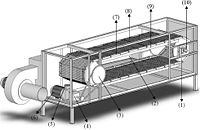Difference between revisions of "Continuous Band Dryers"
Jump to navigation
Jump to search

| Line 5: | Line 5: | ||
* Please start editing this page after the /noinclude | * Please start editing this page after the /noinclude | ||
* -------------------------------------------------></noinclude> | * -------------------------------------------------></noinclude> | ||
[[File:Continuous_Band_Dryers.jpg|thumb|200px|right|Continuous Band Dryers]] | [[File:Continuous_Band_Dryers.jpg|thumb|200px|right|Schematic of Continuous Band Dryers.: sprocket (1); location of major temperature sensor (beneath of upper bands) (2); large scale gear (3); gearbox (4); manual rotation speed controller (for large range) (5); electrical motor (6); chain (7); perforated bands (8); chain guide (9) and shaft and bearing (10).]] | ||
The '''Continuous Band Dryers''' serve to layer materials up to 30 to 100 mm in thickness on the band comprised of wire mesh or perforated sheet and perform drying by feeding hot air from the top or the bottom at right angles to the materials layered. | The '''Continuous Band Dryers''' serve to layer materials up to 30 to 100 mm in thickness on the band comprised of wire mesh or perforated sheet and perform drying by feeding hot air from the top or the bottom at right angles to the materials layered. | ||
==Features== | ==Features== | ||
* Evenly dried products are discharged. | * Evenly dried products are discharged.This dryer is used to dry formed materials, enabling you to get homogeneous products with uneven drying diminished. | ||
This dryer is used to dry formed materials, enabling you to get homogeneous products with uneven drying diminished. | * Products of low moisture content are discharged. Extended contact time makes it possible to dry materials of high internal moisture up to considerably low moisture content. | ||
* Products of low moisture content are discharged. | * Minimized material destruction. Materials are dried in a state of packed layer, enabling you to get products with minimized particle destruction. | ||
Extended contact time makes it possible to dry materials of high internal moisture up to considerably low moisture | * Short drying time. Compared to concurrent-flow compartment dryers, you are able to finish drying step in far shorter period of time. | ||
* Minimized material destruction | * Reduced floor space for drying. Materials can be layered thick in a state of packed bed for shorter drying time, reducing the floor space required for drying as well as the volume of the equipment. | ||
Materials are dried in a state of packed layer, enabling you to get products with minimized particle destruction. | * Diminished flying of materials. Materials are dried as they are left at rest to diminish their flying, enabling you to cut the costs of flue gas treatment. | ||
* Short drying time | |||
Compared to concurrent-flow compartment dryers, you are able to finish drying step in far shorter period of time. | |||
* Reduced floor space for drying | |||
Materials can be layered thick in a state of packed bed for shorter drying time, reducing the floor space required for drying as well as the volume of the equipment. | |||
* Diminished flying of materials | |||
Materials are dried as they are left at rest to diminish their flying, enabling you to cut the costs of flue gas treatment. | |||
Latest revision as of 22:07, 19 August 2012

Schematic of Continuous Band Dryers.: sprocket (1); location of major temperature sensor (beneath of upper bands) (2); large scale gear (3); gearbox (4); manual rotation speed controller (for large range) (5); electrical motor (6); chain (7); perforated bands (8); chain guide (9) and shaft and bearing (10).
The Continuous Band Dryers serve to layer materials up to 30 to 100 mm in thickness on the band comprised of wire mesh or perforated sheet and perform drying by feeding hot air from the top or the bottom at right angles to the materials layered.
Features
- Evenly dried products are discharged.This dryer is used to dry formed materials, enabling you to get homogeneous products with uneven drying diminished.
- Products of low moisture content are discharged. Extended contact time makes it possible to dry materials of high internal moisture up to considerably low moisture content.
- Minimized material destruction. Materials are dried in a state of packed layer, enabling you to get products with minimized particle destruction.
- Short drying time. Compared to concurrent-flow compartment dryers, you are able to finish drying step in far shorter period of time.
- Reduced floor space for drying. Materials can be layered thick in a state of packed bed for shorter drying time, reducing the floor space required for drying as well as the volume of the equipment.
- Diminished flying of materials. Materials are dried as they are left at rest to diminish their flying, enabling you to cut the costs of flue gas treatment.
Applications
- Fibrous materials
- Solids forming of sludgy materials
- Calcium carbonate and magnesium carbonate
- Titanium oxide, white carbon, and carbon black
- Synthetic resin pellets